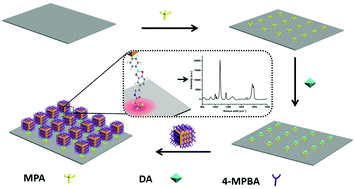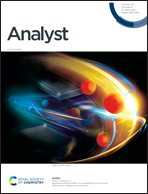Silver nanocube coupling with a nanoporous silver film for dual-molecule recognition based ultrasensitive SERS detection of dopamine†
Abstract
Dopamine (DA) is one of the catecholamine neurotransmitters used for the treatment of neural disorders. In this study, a novel sensor based on surface-enhanced Raman scattering (SERS) with dual molecule-recognition for ultrasensitive detection of DA was presented, with a limit of detection (LOD) of 40 fM, without any pretreatment of clinical samples. To realize the sensitive and selective detection of DA in complex samples, the nanoporous silver film (AgNF) surfaces were functionalized with mercaptopropionic acid (MPA) to accurately capture DA, while silver nanocubes (AgNCs) were modified with 4-mercaptobenzene boronic acid (4-MPBA) as a Raman reporter for the quantitative detection of DA. The nanogaps between AgNCs and the AgNF led to the generation of an abundance of hot spots for the SERS signal and thus effectively improved the sensitivity of DA detection. Measurements of DA concentrations in clinical body fluids such as human serum and urine samples are also demonstrated, showing excellent performance for DA detection in a complex environment. Our results demonstrate the promising potential for the ultrasensitive detection of DA for the potential diagnosis of DA-related diseases.


 Please wait while we load your content...
Please wait while we load your content...